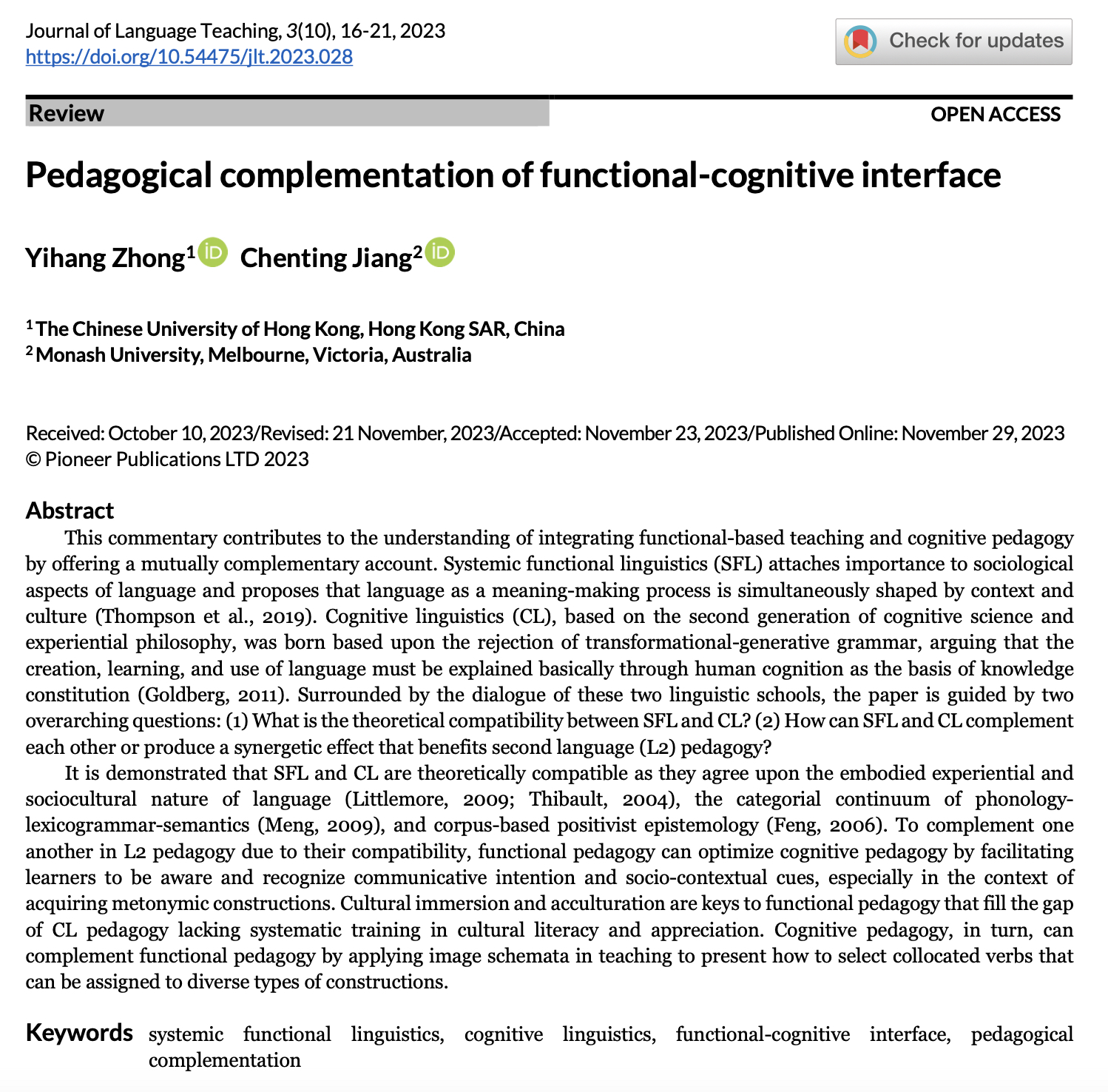Pedagogical complementation of functional-cognitive interface
DOI:
https://doi.org/10.54475/jlt.2023.028Keywords:
systemic functional linguistics, cognitive linguistics, functional-cognitive interface, pedagogical complementationAbstract
This commentary contributes to the understanding of integrating functional-based teaching and cognitive pedagogy by offering a mutually complementary account. Systemic functional linguistics (SFL) attaches importance to sociological aspects of language and proposes that language as a meaning-making process is simultaneously shaped by context and culture (Thompson et al., 2019). Cognitive linguistics (CL), based on the second generation of cognitive science and experiential philosophy, was born based upon the rejection of transformational-generative grammar, arguing that the creation, learning, and use of language must be explained basically through human cognition as the basis of knowledge constitution (Goldberg, 2011). Surrounded by the dialogue of these two linguistic schools, the paper is guided by two overarching questions: (1) What is the theoretical compatibility between SFL and CL? (2) How can SFL and CL complement each other or produce a synergetic effect that benefits second language (L2) pedagogy? It is demonstrated that SFL and CL are theoretically compatible as they agree upon the embodied experiential and sociocultural nature of language (Littlemore, 2009; Thibault, 2004), the categorial continuum of phonology-lexicogrammar-semantics (Meng, 2009), and corpus-based positivist epistemology (Feng, 2006). To complement one another in L2 pedagogy due to their compatibility, functional pedagogy can optimize cognitive pedagogy by facilitating learners to be aware and recognize communicative intention and socio-contextual cues, especially in the context of acquiring metonymic constructions. Cultural immersion and acculturation are keys to functional pedagogy that fill the gap of CL pedagogy lacking systematic training in cultural literacy and appreciation. Cognitive pedagogy, in turn, can complement functional pedagogy by applying image schemata in teaching to present how to select collocated verbs that can be assigned to diverse types of constructions.
References
Bartley, L. V. (2018). Putting transitivity to the test: A review of the Sydney & Cardiff models. Functional Linguistics, 5(1). https://doi.org/10.1186/s40554-018-0056-x
Blumenthal-Dramé, A. (2012). Entrenchment in usage-based theories: What corpus data do & do not reveal about the mind. De Gruyter Mouton.
Butler, C. S. & Gonzálvez-García, F. (2014). Exploring functional-cognitive space. John Benjamins Publishing Company.
Chen, X. J. (2012). “V来V去”格式对动词的选择及语义分析 [Verb selection & semantic analysis of the Chinese construction V来V去]. Read, Write & Count, 2(19), 14.
Coffin, C. & Donohue, J. P. (2012). Academic literacies & systemic functional linguistics: How do they relate? Journal of English for Academic Purposes, 11(1), 64-75. https://doi.org/10.1016/j.jeap.2011.11.004
Dornyei, Z. & Thurrell, S. (1994). Teaching conversational skills intensively: course content & rationale. English Language Teaching Journal, 48, 40-49.
Feng, Z. X. (2006). Introduction to modern linguistic schools. Beijing University Press
Forey, G. (2020). A whole school approach to SFL metalanguage & the explicit teaching of language for curriculum learning. Journal of English for Academic Purposes, 44(2020), 1-17. https://doi.org/10.1016/j.jeap.2019.100822
García, P., Sagre, A., & Lacharme, A. (2014). Systemic functional linguistics & discourse analysis as alternatives when dealing with texts. Profile, 16(2), 101-116. https://doi.org/10.15446/profile.v16n2.38113
Goldberg, A. E. (2011). Cognitive linguistics. Routledge.
Hamblyn, R. (2021). The sea: Nature & culture. Reaktion Books.
He, Y. M. (2023). The agricultural civilization of ancient China (1st ed.). Springer. https://doi.org/10.1007/978-981-19-8469-3
Hoffmann, T. & Trousdale, G. (2013). The Oxford handbook of construction grammar. Oxford University Press.
Kasper, G., & Roever, C. (2005). Pragmatics in second language learning. In Doughty, C. J., & Long, M. H. (Eds.), Handbook of research in second language teaching and learning (pp. 317-334). Routledge. https://doi.org/10.4324/9781410612700-28
Kyle, K. & Crossley, S. (2017). Assessing syntactic sophistication in L2 writing: A usage-based approach. Language Testing, 34(4), 513-535. https://doi.org/10.1177/0265532217712554
Li, Y. & Wang. L. (2019). Cognitive linguistics: Theory & application. China Economy Publishing House.
Littlemore, J. (2009). Applying cognitive linguistics to second language learning & teaching. Palgrave Macmillan.
Meng, Q. L. (2009). Introduction to modern linguistic schools (Book Review). Technology Information, 23, 539-576. https://doi.org/10.3969/j.issn.1001-9960.2009.23.409
Moncada L. S. & Xin, Z. Y. (2020). Language education & systemic functional linguistics: A state-of-the-art review. Journal of Literature & Language Teaching, 11(2), 234-249. https://doi.org/10.15642/NOBEL.2020.11.2.234-249
Muntigl, P. (2002). Construing experience through meaning: A language-based approach to cognition (Book Review). Canadian Journal of Linguistics, 47(1-2), 88-93. Canadian Linguistic Association.
Noel, D. (2002). Pattern grammar: A corpus-driven approach to the lexical grammar of English (Book Review). Language, 78(2), 345-346. https://doi.org/10.1353/lan.2002.0115
Ryshina-Pankova, M. & McKnight, D. C. (2023). Specifying the literacy pedagogy moves through genre-based instruction for advanced second language teaching: developing multiple literacies through systemic functional linguistics. Pedagogies (Mahwah, N.J.), 18(3), 534-554. https://doi.org/10.1080/1554480X.2022.2077339
Shi, Y. Z. (2020). Bidirectional transfers of the ditransitive construction in Chinese. Cognitive Linguistic Studies, 7(2), 416-439. https://doi.org/10.1075/cogls.00063.shi
The University of British Columbia. (2010). Language evolving: some systemic functional reflections on the history of meaning [Video]. YouTube. https://www.youtube.com/watch?v=nC-blhaIUCk
Thibault, P. J. (2004). Brain, mind & the signifying body: An ecosocial semiotic theory. Continuum.
Thompson, G., Bowcher, W. L., Fontaine, L., & Schönthal, D. (2019). The Cambridge handbook of systemic functional linguistics. Cambridge University Press.
Victorian Curriculum & Assessment Authority. (2022). English as an additional language exam paper. https://www.vcaa.vic.edu.au/Documents/exams/english/2022/NHT/2022EAL-NHT-w.pdf
Victorian Curriculum & Assessment Authority. (2022). English as an additional language study design. https://www.vcaa.vic.edu.au/Documents/vce/english/2016EnglishEALSD.pdf
Xuan, W. H. (2022). Writing as meaning-making: a systemic functional linguistic approach to EFL writing. Springer Nature Singapore.

Downloads
Published
Issue
Section
License
Copyright (c) 2023 Journal of Language Teaching

This work is licensed under a Creative Commons Attribution 4.0 International License.




